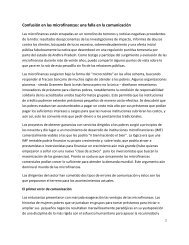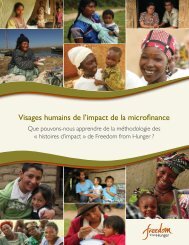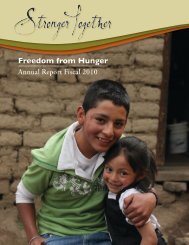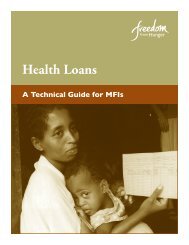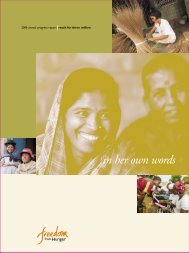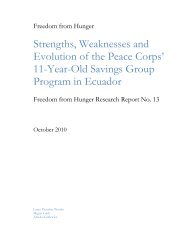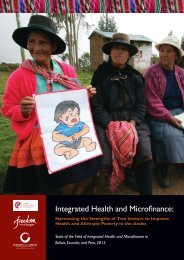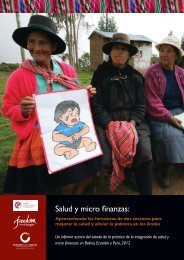history of meals for millions, soy, and freedom from ... - SoyInfo Center
history of meals for millions, soy, and freedom from ... - SoyInfo Center
history of meals for millions, soy, and freedom from ... - SoyInfo Center
Create successful ePaper yourself
Turn your PDF publications into a flip-book with our unique Google optimized e-Paper software.
“Its policy should not be restricted to advice, <strong>and</strong> then<br />
only when asked <strong>for</strong> by a government. Its policy should be<br />
action, it should find out what is needed <strong>and</strong> work out ways<br />
<strong>and</strong> means to get better nutrition to the peoples in need<br />
quickly. Its policy should be that it will act with government<br />
<strong>of</strong>ficials when they want help.<br />
“When confronted with ‘the bureaucratic habit <strong>of</strong><br />
obstruction, delay <strong>and</strong> timidity to stick its neck out, the new<br />
agency should by-pass government.” And when “confronted<br />
by bureaucratic scientists, it should by-pass them <strong>and</strong> turn to<br />
the scientists who are not bureaucrats, who, having the<br />
facts, want to act on them. The new agency should seek out<br />
all who are willing <strong>and</strong> can help:...” Lord Boyd-Orr<br />
lamented that:<br />
“‘Governments are prepared to unite men <strong>and</strong> resources<br />
<strong>for</strong> a world war but the Great Powers are not prepared to<br />
unite to banish hunger <strong>and</strong> poverty <strong>from</strong> the world... People<br />
ask <strong>for</strong> bread <strong>and</strong> we give them pamphlets’” (p. 8).<br />
“With this suggestion <strong>for</strong> the creation <strong>of</strong> a new<br />
international agency, whose doctrine, policy, <strong>and</strong> tactics<br />
would bear a striking similarity to those <strong>of</strong> Meals <strong>for</strong><br />
Millions, the father <strong>of</strong> MPF ended his bluntly worded<br />
speech to the Second Annual Inter-American Food<br />
Congress” (Roberts 1967, p. 187).<br />
“Predictably, given Dr. Borsook’s association with<br />
Meals <strong>for</strong> Millions <strong>and</strong> his espousal <strong>of</strong> MPF, the Foundation<br />
[MFM] soon became the target <strong>of</strong> the anger which the<br />
Research Director’s harsh <strong>and</strong> public criticism <strong>of</strong> FAO,<br />
WHO, <strong>and</strong> UNICEF inevitably aroused among UN<br />
<strong>of</strong>ficials” (Roberts 1967, p. 187). The next 9 pages <strong>of</strong><br />
Roberts’ PhD thesis discuss the fallout <strong>from</strong> this speech,<br />
with mention <strong>of</strong> Fred Hafner, Dr. Richard Hayward, Dr.<br />
Sebrell, Dr. Van Veen, Dr. Max Miler, Mr. Louis H. Bean,<br />
Dr. Sabin, Dr. Donald F. Ebright. From June 1959 onwards<br />
“UNICEF have not shown the slightest desire to cooperate<br />
with MFM or to support the overseas production <strong>of</strong> MPF.”<br />
“MFM resented UNICEF’s refusal to publicly acknowledge<br />
the existence <strong>of</strong> MPF”–when they acknowledged <strong>and</strong><br />
encouraged Saridele in Indonesia <strong>and</strong> Incaparina in Central<br />
America (Roberts 1967, p. 188-91).<br />
Note: A mimeograph copy <strong>of</strong> this speech is at the Meals<br />
<strong>for</strong> Millions archives at Special Collections at UCLA (Los<br />
Angeles), Collection No. 1107, Box 32, Notebook No. 3.<br />
Address: Pr<strong>of</strong>. <strong>of</strong> Biochemistry, Cali<strong>for</strong>nia Inst. <strong>of</strong><br />
Technology, Research Director, Meals <strong>for</strong> Millions, 115 W.<br />
7th St., Los Angeles 14, Cali<strong>for</strong>nia, U.S.A.<br />
134. Hafner, Fred H. 1959. Sees important role <strong>for</strong> <strong>soy</strong> in<br />
India. Soybean Digest. July. p. 28-29.<br />
• Summary: Toasted <strong>soy</strong> protein is seen as a promising food<br />
<strong>for</strong> India. No mention is made <strong>of</strong> Meals <strong>for</strong> Millions or its<br />
Multi-Purpose Food.<br />
MEALS FOR MILLIONS, SOY, AND FREEDOM FROM HUNGER 59<br />
© Copyright Soyinfo <strong>Center</strong> 2011<br />
135. Hilgenstuhler, T. 1959. L.A. man’s friendship food<br />
saves starving <strong>millions</strong>. Los Angeles Herald & Express.<br />
Aug. 17. p. A-10+. Monday.<br />
• Summary: About Meals <strong>for</strong> Millions. Address: Los<br />
Angeles, Cali<strong>for</strong>nia.<br />
136. Wall Street Journal.1959. General Mills plans to make<br />
low-cost “multi-purpose” food Oct. 14.<br />
• Summary: On Dec. 1 General Mills plans to begin<br />
manufacture <strong>and</strong> sale <strong>of</strong> multi-purpose food, a <strong>soy</strong>-based<br />
product aimed at providing low-cost nutrition.<br />
Note: This is the earliest document seen (Sept. 2010)<br />
showing an association between General Mills <strong>and</strong> Multi-<br />
Purpose Food (or Meals <strong>for</strong> Millions). General Mills started<br />
making Textured Soy Protein (TSP), the main ingredient in<br />
Multi-Purpose Food in about Dec. 1957 (see article in<br />
Soybean Digest, Dec. 1957, p. 23).<br />
137. Chemurgic Digest.1959. Multi-purpose food. Oct. p. 3.<br />
• Summary: “According to Wall Street Journal, General<br />
Mills Inc., has said it will begin manufacture <strong>and</strong> sale<br />
December 1 <strong>of</strong> a <strong>soy</strong>bean product called ‘multi-purpose’<br />
food, aimed at providing low cost nutrition.” The firm,<br />
based in Minneapolis, Minnesota, “said the granular food<br />
product will sell at wholesale <strong>for</strong> about 2½ cents <strong>for</strong> a twoounce<br />
serving. One such serving provides one-third <strong>of</strong> all<br />
daily protein, vitamin <strong>and</strong> mineral requirements, the<br />
company said...<br />
“Sales to <strong>for</strong>eign countries will be made through a nonpr<strong>of</strong>it<br />
group, Meals <strong>for</strong> Millions Foundation, Inc., <strong>of</strong> Los<br />
Angeles. The foundation has distributed more than 100<br />
million such <strong>meals</strong> abroad since 1946, the company said.<br />
The product was developed by Dr. Henry Borsook <strong>of</strong> the<br />
Cali<strong>for</strong>nia Institute <strong>of</strong> Technology. It can be prepared by<br />
adding boiling water <strong>and</strong> a seasoning.”<br />
138. FAO Nutrition Meetings Report Series.1959. Report <strong>of</strong><br />
the FAO/UNICEF Regional School Feeding Seminar <strong>for</strong><br />
Asia <strong>and</strong> the Far East. No. 22. 53 p. Held 10-19 Nov. 1958<br />
at Tokyo, Japan. [5 <strong>soy</strong> ref]<br />
• Summary: UNICEF st<strong>and</strong>s <strong>for</strong> the United Nations<br />
International Children’s Emergency Fund. Appendix 3 (p.<br />
48-51) titled “Data on some nutritious food products that<br />
have been developed in Asia <strong>and</strong> the Far East,” discusses<br />
Saridele, groundnut extract curd [t<strong>of</strong>u made <strong>from</strong> peanut<br />
milk], Indian Multipurpose Food (MPF, developed by<br />
CFTRI), miso, natto, <strong>and</strong> tempeh.<br />
“‘Saridele’ is the name that has been given to a spraydried<br />
<strong>soy</strong>bean extract combined with an extract <strong>of</strong> sesame,<br />
or peanut, with or without the addition <strong>of</strong> malt. Vitamins<br />
<strong>and</strong> calcium are added to saridele in order to make its<br />
nutritive value similar to that <strong>of</strong> cow’s milk or to enhance its<br />
nutritive value. Flavorings such as vanilla or chocolate are<br />
also used, which make the product highly acceptable.



